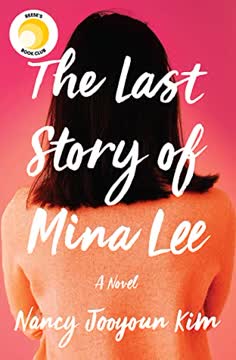Plot Summary
Vanished Calls, Unanswered Doors
Margot Lee, a young Korean American woman, grows anxious when her mother, Mina, suddenly stops answering the phone. Margot's life in Seattle is busy and distant, but the silence from her mother's Koreatown apartment gnaws at her. She drives down to Los Angeles with her friend Miguel, haunted by memories of her mother's quiet resilience and their fraught, half-understood conversations. The journey is heavy with guilt and the unspoken distance between mother and daughter, both linguistic and emotional. Margot's anxiety is laced with regret for not knowing her mother better, for not bridging the gap between their worlds. The rain and the road become metaphors for the uncertainty and fear that now define Margot's return home.
The Body on the Carpet
Arriving at the familiar, shabby apartment, Margot is overwhelmed by shame and old resentments. The door is unlocked, and inside, a putrid smell and a scene of chaos await. Mina lies face down on the carpet, lifeless. Margot's screams echo her childhood fears and adult regrets. The police and neighbors are of little help, and Margot is left with a sense of how little she truly knew about her mother's life, her struggles, and her secrets. The discovery is not just of a body, but of a chasm between them, filled with all the things left unsaid and undone.
Orphan's Arrival in America
Thirty years earlier, Mina arrives in Los Angeles, carrying the trauma of being separated from her parents during the Korean War. She is alone, undocumented, and determined to survive. The city is overwhelming, but she finds a place to stay in Koreatown and begins the slow, painful process of building a new life. Her memories of loss and displacement haunt her, but she is driven by the hope of something better. The kindness of strangers and the small rituals of food and language become her anchors in a world that is both foreign and indifferent.
Shelves, Sweat, and Survival
Mina finds work stocking shelves at a Korean supermarket, where the labor is grueling and the pay meager. She is surrounded by other immigrants, each carrying their own burdens and dreams. The monotony of work is both a comfort and a prison. Mina's interactions with coworkers—Latino, Korean, and others—reveal the complexities of immigrant life, where solidarity and prejudice coexist. The supermarket becomes a microcosm of survival, where Mina's strength and vulnerability are tested daily. Her longing for connection is palpable, but so is her fear of further loss.
Language, Shame, and Distance
Margot reflects on her childhood, marked by shame over her mother's accent, their poverty, and their outsider status. Language is both a bridge and a barrier; Margot's Korean is halting, Mina's English is limited. Their conversations are fraught with misunderstanding and frustration. Margot's American identity is shaped by a desire to escape her mother's world, yet she is tethered to it by love and obligation. The emotional distance between them is mirrored in their physical separation, and Margot's guilt grows as she confronts the reality of her mother's isolation.
The Secret Vegas Trip
Margot recalls a childhood trip to Las Vegas with her mother, a rare adventure that ended in disappointment and confusion. Mina's motives are unclear, but the trip is later revealed to be an attempt to reconnect with a lost love, Mr. Kim. The memory is tinged with longing and regret, emblematic of the secrets Mina kept and the sacrifices she made. The trip becomes a symbol of the unspoken desires and heartbreaks that defined Mina's life, and of Margot's inability to understand her mother's pain until it is too late.
The Grocery Store Affair
In the late 1980s, Mina falls in love with Mr. Kim, a gentle coworker at the supermarket. Their relationship is a rare source of joy for Mina, but it is complicated by Mr. Kim's undocumented status and the dangers posed by their predatory boss, Mr. Park. When Mr. Kim intervenes to protect a coworker from Mr. Park's assault, he is forced to flee, leaving Mina alone and pregnant. The affair is a turning point in Mina's life, leading to Margot's birth and a lifetime of secrets. The love that could have saved Mina instead becomes another source of loss.
Friends, Foes, and Fears
Mina's life is shaped by her relationships with other women, especially Mrs. Baek, a fellow survivor with her own hidden traumas. Their friendship is a lifeline, but both are haunted by men who threaten their safety and autonomy. Mr. Park, now a restaurant owner, becomes a stalker, forcing Mrs. Baek into hiding. The women's solidarity is tested by fear, shame, and the ever-present threat of violence. Their stories intertwine, revealing the ways women protect and fail each other in a world that is often hostile to their survival.
The Net of Memory
In the aftermath of Mina's death, Margot is consumed by the need to understand her mother's life. She uncovers clues—a safety-deposit key, old photographs, an obituary—that point to a hidden past. Margot's investigation leads her to confront her own assumptions, her father's identity, and the web of relationships that shaped her family. The metaphor of the fishing net recurs, symbolizing the elusive nature of truth and the ways memory both traps and frees us. Margot's journey is as much about self-discovery as it is about solving the mystery of her mother's death.
The Stalker and the Gun
As Margot and Mrs. Baek piece together the events leading to Mina's death, the threat of Mr. Park looms large. The gun, a symbol of both vulnerability and agency, passes from Mina to Mrs. Baek as a means of protection. The women's fear is palpable, but so is their determination to survive. The confrontation with Mr. Park culminates in violence, and the lines between victim and perpetrator blur. The legacy of trauma is passed down, but so is the will to fight back.
Reunion and Rupture
Margot finally learns the truth about her father, Mr. Kim, and the other family Mina left behind in Korea. The revelations are bittersweet, offering closure but also new wounds. The reunion with Mrs. Baek is fraught with guilt and grief, as the circumstances of Mina's death come to light. The women's stories converge in a moment of reckoning, where forgiveness and understanding are hard-won. The rupture between past and present, mother and daughter, is both healed and made permanent by the truths they uncover.
The Grand Canyon Goodbye
In her final months, Mina reconnects with Mr. Kim, and together they travel to the Grand Canyon—a long-held dream. The trip is a brief respite from a lifetime of hardship, a moment of beauty and peace before the end. Mr. Kim's death soon follows, and Mina is left to grieve alone. The Grand Canyon becomes a symbol of the vastness of loss and the possibility of transcendence. Mina's story is one of endurance, but also of fleeting joy and the hope that love, however brief, can redeem a life.
The Safety Deposit Key
Margot discovers the key to her mother's safety-deposit box, unlocking a trove of documents and photographs that reveal Mina's hidden history. The contents force Margot to confront the complexity of her mother's choices—the family left behind, the traumas survived, the sacrifices made. The act of opening the box is both literal and metaphorical, a final gesture of connection between mother and daughter. Margot is left with the responsibility of carrying her mother's story forward, of making sense of a legacy that is both painful and precious.
The Truth in the Ashes
As Margot prepares to scatter her mother's ashes, she reflects on the journey they have both taken—from Korea to America, from loss to survival, from silence to understanding. The truth of Mina's life is messy and incomplete, but it is enough. Margot finds solace in the knowledge that love endures, even in the face of death and separation. The act of letting go is both an ending and a beginning, a way to honor the past while embracing the future.
The Last Story of Mina Lee
The novel closes with Margot reaching out to her grandmother in Korea, seeking connection across generations and continents. The story of Mina Lee is not just one of tragedy, but of resilience, hope, and the enduring bonds of family. Margot's journey is a testament to the power of storytelling—to heal, to remember, and to forgive. The last story is not just Mina's, but Margot's as well—a story of becoming, of finding one's place in the world, and of carrying forward the legacy of those who came before.
Characters
Margot Lee
Margot is the American-born daughter of Mina Lee, caught between two cultures and two languages. Her relationship with her mother is marked by love, frustration, and a deep sense of guilt for the distance between them. Margot's journey is one of self-discovery, as she unravels the secrets of her mother's past and confronts her own identity. She is introspective, sensitive, and driven by a need for understanding and connection. Margot's psychological arc moves from shame and resentment to empathy and acceptance, as she learns to see her mother as a whole person, not just as a parent. Her relationships—with friends, lovers, and her mother—are shaped by her struggle to reconcile her American identity with her Korean heritage.
Mina Lee
Mina is a Korean immigrant whose life is defined by trauma, resilience, and sacrifice. Orphaned during the Korean War, she arrives in America alone, undocumented, and determined to survive. Her experiences as a single mother, a low-wage worker, and an outsider shape her worldview and her relationship with Margot. Mina is both strong and vulnerable, capable of great love and deep sorrow. Her secret affair with Mr. Kim, her struggles with language and belonging, and her friendships with other women reveal a complex inner life. Mina's psychological depth is rooted in her endurance and her longing for connection, even as she is haunted by the losses she has endured.
Mrs. Baek (Margaret Johnson)
Mrs. Baek is Mina's closest friend and confidante, herself an immigrant with a history of abuse and reinvention. She is intelligent, resourceful, and fiercely independent, but also deeply wounded by her past. Her relationship with Mina is one of mutual support and occasional conflict, shaped by shared experiences of trauma and survival. Mrs. Baek's own story—her escape from an abusive husband, her struggles with identity, and her eventual entanglement in Mina's death—mirrors and complicates Mina's narrative. She is both a protector and a source of pain, embodying the complexities of female friendship and the burdens of secrecy.
Mr. Kim (Chang-hee Kim)
Mr. Kim is Mina's lover and Margot's biological father, a gentle and compassionate man whose life is marked by displacement and longing. His undocumented status and eventual flight from Los Angeles are the result of both love and fear. Mr. Kim's relationship with Mina is a rare source of happiness for both, but it is ultimately doomed by circumstance. His later reappearance and efforts to help Mina find her family in Korea reveal his enduring care and regret. Mr. Kim's psychological portrait is one of quiet strength, vulnerability, and the enduring hope for reunion and forgiveness.
Mr. Park
Mr. Park is the owner of the supermarket where Mina and Mr. Kim work, and later a restaurant owner and stalker of Mrs. Baek. He embodies the dangers faced by immigrant women—abuse of power, sexual violence, and the threat of retaliation. Mr. Park's actions set in motion many of the novel's tragedies, from Mr. Kim's flight to Mina's isolation and Mrs. Baek's fear. He is a figure of menace and control, whose eventual violent end is both a form of justice and a commentary on the limits of the law.
Miguel
Miguel is Margot's close friend, a gay Latino man who provides support, humor, and perspective throughout her journey. His own experiences with family, identity, and secrecy parallel Margot's, and their friendship is a source of comfort and solidarity. Miguel's presence allows Margot to process her grief and confusion, and his loyalty is unwavering. He represents the chosen family that sustains Margot when her biological ties are strained or broken.
Alma
Alma is a longtime friend of Mina's and a fellow shop owner at the swap meet. She provides Margot with crucial information about Mina's recent behavior and emotional state. Alma's role is that of a bridge between cultures and generations, embodying the solidarity and support that can exist within immigrant communities. Her relationship with Mina and Margot is marked by empathy and shared struggle.
Officer Choi (David)
Officer Choi is the Korean American police officer who handles Mina's case. Initially distant and procedural, he becomes more sympathetic as Margot challenges his assumptions and pushes for answers. His own experiences with loss and the limitations of the justice system mirror the novel's themes of powerlessness and the search for truth. David's eventual decision to leave the police force reflects his disillusionment and desire for more meaningful work.
Lupe
Lupe is a coworker at the supermarket who is assaulted by Mr. Park. Her victimization and Mr. Kim's intervention are pivotal events that lead to Mr. Kim's flight and the unraveling of Mina's life. Lupe's story highlights the vulnerability of undocumented women and the failures of the systems meant to protect them. Her resilience and the support she receives from Mina and Mr. Kim underscore the importance of solidarity among the marginalized.
Mina's Mother (in Korea)
Mina's Mother, separated from her during the war, survives in Korea into old age. Her presence in the safety-deposit box documents represents the enduring wounds of separation and the possibility of reconciliation. She is a figure of longing and loss, embodying the generational trauma that shapes Mina's life and, by extension, Margot's.
Plot Devices
Dual Timelines and Interwoven Narratives
The novel alternates between Margot's present-day investigation and Mina's past, creating a tapestry of memory, trauma, and discovery. This structure allows the reader to experience the emotional resonance of each woman's journey, highlighting the ways their lives mirror and diverge. The dual timelines build suspense and deepen the psychological complexity of the narrative, as secrets are revealed and connections are made across time.
The Mystery and the Safety-Deposit Box
The central mystery—how and why Mina died—drives the plot, but it is also a vehicle for exploring deeper questions of identity, belonging, and forgiveness. The discovery of the safety-deposit key and its contents serves as a literal and metaphorical unlocking of the past. Photographs, documents, and personal artifacts become conduits for memory and understanding, bridging the gap between generations.
The Net and the Ferris Wheel
The fishing net is a recurring metaphor for the ways language, memory, and trauma ensnare the characters, while the Ferris wheel represents moments of joy, perspective, and fleeting freedom. These symbols are woven throughout the narrative, reinforcing the themes of entrapment, release, and the cyclical nature of pain and healing.
Foreshadowing and Nonlinear Revelation
The novel employs foreshadowing through dreams, memories, and fragmented conversations, creating a sense of inevitability and tension. Nonlinear revelations—such as the delayed discovery of Mina's other family or the true circumstances of her death—mirror the characters' psychological processes, where understanding comes in fits and starts, often too late.
The Gun and the Stalker
The presence of the gun, passed from Mina to Mrs. Baek, is a plot device that encapsulates the dangers faced by women and the limited means of protection available to them. The threat of Mr. Park, as both a stalker and a symbol of patriarchal violence, drives much of the action and forces the characters to confront their own capacity for resistance and survival.
Analysis
The Last Story of Mina Lee is a poignant exploration of the silences and secrets that shape immigrant families, particularly those of women navigating the intersecting oppressions of race, class, and gender. Through its dual narrative, the novel examines how trauma is inherited and how love is both a source of pain and redemption. The story challenges the myth of the American dream, exposing the precarity and isolation that often define immigrant life. It also interrogates the limitations of language—how words can both connect and divide, and how the inability to communicate can lead to misunderstanding and regret. Ultimately, the novel is a testament to the resilience of women, the necessity of friendship and solidarity, and the power of storytelling to heal and transform. The lessons are clear: understanding requires courage, forgiveness is an act of strength, and the stories we inherit are both burdens and gifts, shaping who we become and how we move forward.
Last updated:
Review Summary
The Last Story of Mina Lee received mixed reviews. Many praised its exploration of immigrant experiences and mother-daughter relationships, finding the dual timeline and cultural insights compelling. Readers appreciated the portrayal of Korean culture and food. However, some felt the pacing was slow, the mystery element weak, and character development lacking. The audiobook narration received criticism. Overall, reviewers found the book emotionally resonant but somewhat uneven in execution, with Mina's chapters generally preferred over Margot's. Despite its flaws, many readers found value in its themes of cultural identity and family dynamics.
Similar Books
Download PDF
Download EPUB
.epub digital book format is ideal for reading ebooks on phones, tablets, and e-readers.









